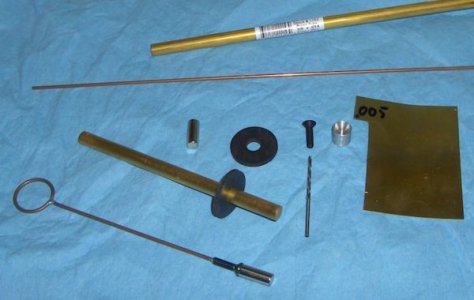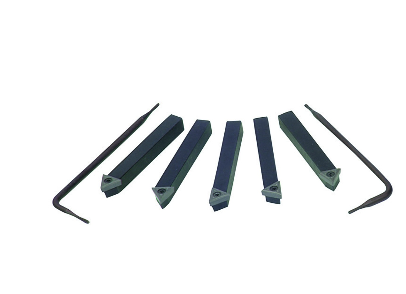-
Welcome back Guest! Did you know you can mentor other members here at H-M? If not, please check out our Relaunch of Hobby Machinist Mentoring Program!
You are using an out of date browser. It may not display this or other websites correctly.
You should upgrade or use an alternative browser.
You should upgrade or use an alternative browser.
Some Useful Lathe Tools
- Thread starter HMF
- Start date
- Joined
- May 16, 2016
- Messages
- 1,704
One of my most useful workshop 'tools' is a telescopic magnet to save me bending down every time I drop a tool or drill bit etc.
Yes, I've got a few of them scattered around the shop, I can no longer pick up anything from the floor. I've also got a couple of those gripper type picker upper things for the non magnetic stuff.
- Joined
- Feb 18, 2017
- Messages
- 2
For collecting swarf i made a gadget with a retractable rare earth magnet inside a capped copper water pipe with a generous size grommet a few inches from the end.Also useful, when I put a polly bag over it, for picking up swarf and chips, reverse the bag and shake into the bin.
I also use poly bags with internal magnets as way protectors and do as above.
Not my idea, this or another forum tip.
Magnet works through the copper to grab a handful of swarf, then when over my shop bin, retract the magnet up the tube and the grommet scrapes off all the swarf.
Best thing since sliced bread.
I used surplus carbon fibre tent pole as the inner shaft but wood dowel would do fine or aluminium. Cost me only for the 2 end caps...total of $2.00
The pole, tube, shaft, magnet and a screw to secure a surplus magnet to the shaft were all in junk stock.
You can buy them for about $80.

Sent from my GT-I9505 using Tapatalk
- Joined
- May 16, 2016
- Messages
- 1,704
For collecting swarf i made a gadget with a retractable rare earth magnet inside a capped copper water pipe with a generous size grommet a few inches from the end.
Magnet works through the copper to grab a handful of swarf, then when over my shop bin, retract the magnet up the tube and the grommet scrapes off all the swarf.
Best thing since sliced bread.
I used surplus carbon fibre tent pole as the inner shaft but wood dowel would do fine or aluminium. Cost me only for the 2 end caps...total of $2.00
The pole, tube, shaft, magnet and a screw to secure a surplus magnet to the shaft were all in junk stock.
You can buy them for about $80.
Sent from my GT-I9505 using Tapatalk
- Joined
- Feb 17, 2013
- Messages
- 4,417
Here's something similar I've made a bunch of. K&S brass tubing, .005" brass shim soft soldered on the end, edges trimmed off, ø8mm x 20mm RE magnet, steel screw (end drilled 3/32") soft soldered to 3/32" copper coated welding rod, rubber washer. I make a batch of them every once in a while and pass them around at machinist club meetings. It's thin enough to reach into the T-slot grooves on a mill table. Just wish I could figger out how to make it work for aluminum 


- Joined
- May 4, 2015
- Messages
- 3,583
You guys talk about BFH , I remember having to use a 20lb sledge to move castings on a boring mill and a open sided planer. That and 6' digging bar , these castings weighed in at about a ton. Lots of good work at everworth machine. It's a wonder all of us who worked there are still alive we repacked the furnace doors and baked them every weekend. Really good guys and friends worked lots of hours together you could count on them that's close knit shop. One old guy was a boozer to the point at lunch if he didn't come back he was drunk at otts down the road. Our foreman would take him home after the shift. I think he saw to much in ww11 . Lots of my friends did .
- Joined
- Jul 28, 2017
- Messages
- 2,562
A "good" end mill can be used as a small boring bar, too. I once made a decorative spinning water sprinkler which used nested brass tubing and some brass rings for the rotating seal. The rings were separated by nylon balls for a low-friction bearing (all this stuff went inside some 1/2" copper tubing). I needed to turn the IDs of the brass rings to match the two pieces of nesting brass tubing, but all my standard boring bars were too big. After some thought I grabbed my smallest end mill whose shank matched my boring bar holder, rotated it so one of the cutters was in line with the cross slide motion, and went to work. It worked beautifully. I was concerned about the "grab" that might result, since the cutter effectively has a large positive rake (and I was machining brass), but it went fine -- I just took it easy with a lot of light cuts.
Caveat: This would work OK with softer materials but boring steel might produce an uneven wear pattern on the end mill.
Caveat: This would work OK with softer materials but boring steel might produce an uneven wear pattern on the end mill.
A DRO has two advantages, at least for me:
(1) It saves counting turns. This is especially nice with Chinese tools that have metric leadscrews and pseudo-inch calibrations on the dials, or else 1/16" pitch leadscrews. It's always a challenge to convert an inch measurement to turns in these circumstances. Yes, it can be done. But when I'm machining, I want to use the limited bandwidth of my aging brain to decide on details other than keeping track of turns.
(2) It lets you know where you are (OK ... where the tool is) regardless of backlash. You don't have to keep track of which way you last turned the crank. Think of using an edge finder to find the center of a part, where you have to approach opposite faces from opposite directions. Again, it can be done. But to do a good job, you have to know the amount of backlash to a gnat's eyelash. Very easy to make a mistake.
YMMV
Great for pitching out holes
Sent from my iPod touch using Tapatalk

